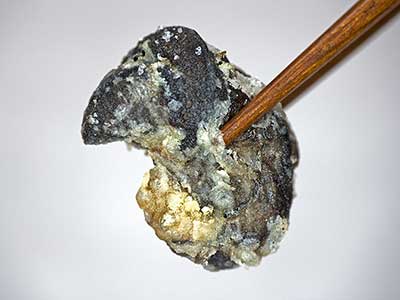April 6, 2015
Amuse-Bouche

escargots croustillantes
(crispy snails)
The stuff was called Bug-Geta, and I used it by the boxful. It didn’t seem to work, but I keep using it in between more ecological and pet friendly attempts to win my personal war with garden snails.
I was trying to grow vegetables in a small plot of half-hidden land in front of my house. When we moved in, the area was covered with gravel. I scraped the gravel off the surface and used it to build a few pathways. Then I started to spade the soil and amend it. I built a compost pile but nothing seemed to decompose in it. I purchased manure and turned that into the soil. I did everything the Sunset Garden Guide and the Rodale’s Gardening magazine instructed me to do.
Finally, it came time to plant. I bought seeds from my local nursery. I built furrows and ridges with the recommended height and spacing. I planted the seeds the recommended depth. I gently watered my new adventure. I waited. I waited some more. When something green did pop through my unfriendly soil, it was usually gone the next day. The hardier seedlings, like the green beans, grew to a foot in height before being decimated. I couldn’t grow vegetables, but I could produce a nice crop of snails.
I tried various methods to combat the critters. I went on midnight hunts armed with a flashlight and the will to crush my prey. I sprinkled dried chili-pepper flakes around the seedlings. I built water-filled moats in metal troughs between the rows. And when my environmentally conscious, first wife wasn’t watching, I spread liberal amounts of the Bug-Geta over my garden. I could almost hear the snails laughing at my efforts.
I learned from a trip to my local branch of the city library that the snails in my garden were probably a variety called petit-gris, the French name for the Helix aspersa species of gastropod. I also learned that these snails were not native to my area, but that they were an invading species. Duh. I also found instructions for how to purge and precook them so they could be served in butter and garlic.
This was 1975. It would be about twenty years until I finally ate a snail or two in butter and garlic. I don’t remember the circumstances. It was probably in France. It must have happened after October, 1994. That is the date of my first trip to France. It must have happened before 1999. That spring I saw a cookbook at the train station in Dijon that featured a full-color picture of six Brussels sprouts arranged in a circle around a dollop of garlic puree and swimming in a chive-filled sauce that flooded the bottom of the plate. It was a book about the cooking of the Burgundy and featured recipes from the area’s most famous chefs. I bought the book, Saveurs & Terroirs de Bourgogne, later that week in Paris, and by then had devoured copious snails on many occasions. What looked like Brussels sprouts on the cover was snail-stuffed cabbage leaves. The book introduced me to Bernard Loiseau, a chef with a Michelin three-star restaurant called La Cote d’Or in Saulieu, a hour west of that train station. The cover recipe was by a different chef, but Loiseau had many recipes in the book, including some with snails. In the years since, I’ve prepared most of the recipes I found there and many more in a number of his other books.
In the fall of 1999, my second wife and I went for a car journey through Burgundy, Lorraine, Alsace, and the Jura. The first night of the journey was spent in the hotel at La Cote d’Or, and we ate dinner in the restaurant. As was the case in starred restaurants out in the countryside, we were first seated in the lounge so we could partake in an apéritif and an amuse-bouche or two. This was also where the maître d’hôtel brought us the carte and returned to record our order for the evening. Loiseau came out of the kitchen to greet a gray-bearded gentleman dressed head-to-toe in faded blue denim. The gentleman seemed like some celebrity. Loiseau didn’t greet us.
I remember that there were two amuse-bouche served that evening, but only one was memorable. That amuse-bouche was a single, crispy snail. One of Loiseau’s recipes in that book I had previously purchased looked like crispy snails in one of the pictures, but the accompanying recipe was for a less-than crispy critter. Now, almost 15 years later, I’ve decided to recreate that snail of my memory.
I started with canned snails. Canned snails are pre-cooked. Part of my delay in doing this recipe is that for the last ten years I’ve only been able to find cans containing six dozen extra-large snails. That’s a lot of amuse-bouche. I finally decided that even if I have to throw many of them away, I had to try the preparation.
Since Loiseau’s snails were crispy on the outside, I first tried coating them with cornstarch before deep frying. These never browned well. I noticed that the outer surface of the snail crisped up under the starch coating. So I tried some without any coating. They did get crispy, but the insides were overcooked. For my third attempt I tried plain, all-purpose flour. That seemed to work.
So, the final instructions are to start with canned, extra-large snails. Rinse them well. Drain well. Toss with all-purpose flour. Shake off any excess flour. Deep fry until crispy and slightly brown in vegetable oil at 180 °C (355 °F). Drain on absorbent paper. Sprinkle lightly with fine salt. Serve. That’s it. Simple and quick.
© 2015 Peter Hertzmann. All rights reserved.
